Smotherman Bennett, Danielle. 2023. “My Fair Lady: Exploring Social Change through Athenian Vase-Painting in the Fifth Century BCE.” In “The Athenian Empire Anew: Acting Hegemonically, Reacting Locally in the Athenian Arkhē,” ed. Aaron Hershkowitz and Michael McGlin, special issue, Classics@ 23. https://nrs.harvard.edu/URN-3:HLNC.ESSAY:103490529.
Abstract
Coincident with the establishment of the Athenian arkhē, the fifth century BCE is a period of political and social change within Athens itself as well as abroad. By looking at variations in the imagery of Athenian vase-painting during this period we can perceive how these social changes are represented in contemporary media. A comparison of wedding images produced throughout the fifth century BCE shows a change in how women are portrayed and how they interact with their grooms. There is also an overall shift to imagery that gives a new prominence to the “fair,” upper-class ladies of Athenian society. During the time of Pericles, legislation made the civic status of women an important factor in the establishment of male citizenship, and the increased visual prominence of non-mythological women reflects these political changes. These classes of women were already represented in the Archaic period, but they become more visible and appear in images targeted to female viewers. The vase-paintings act to reinforce cultural and social institutions, to evoke a response, and to confirm the social status of individuals, especially crucial in this period of change. The images on self-referential wedding vases encourage the female viewer to identify with depicted figures, while also reinforcing the visibility of ordinary, non-mythical female figures in domestic settings. This self-identification creates a more direct connection between object and viewer, as well as extending the depicted conversation to the audience. The ancient viewer could draw on his or her own life experiences alongside the visual markers in order to contextualize the details of the image. The vase-paintings both construe and visually reinforce particular social expectations in a period when those expectations were still in flux. This study reveals that visual markers within these images were applied differentially for male and female-targeted audiences in Athenian society in the fifth century BCE.
0. Introduction
Coinciding with the establishment of the Athenian arkhē, the fifth century BCE is a period of political and social change within Athens itself. In this paper, I will explore the developments in Athenian vase-painting during the fifth century BCE with a specific focus on the images of women. [1] By looking at variations in Athenian vase-painting during this period we can perceive how the social changes of the period are represented in contemporary media. As Athens gains prominence in the Delian League, the spread of economic wealth to citizens, the growth of social classes, and the possibility of upward mobility are reflected in images crafted with broader social appeal. With regards to women, one major political change during this time is the Citizenship Law of 451/450 BCE (Aristotle, Athenian Constitution, 26.3-4). This law restricts Athenian citizenship through both the paternal and maternal lines, when previously only the paternal line mattered. The civic status of women, while not conferring the ability to vote in the democracy or other rights of male citizens, did affect the ability to participate in festivals and hold public religious roles, as well as the political status of children. [2] Overall, there are some dramatic shifts in the imagery during this time that, when understood within the contemporary historical context of the Athenian arkhē, help to illustrate the larger social changes that are occurring. Among these shifts in the imagery, there is a general trend that gives a new prominence to the “fair,” upper-class ladies of Athenian society in images with a broader social appeal through fairly anonymous depictions of women. The increased visual prominence of non-mythological women in Athenian imagery during this time appears to reflect political changes concerning citizenship. The vase-paintings act to reinforce cultural and social institutions, to evoke a response, and to confirm the social status of individuals, especially in this period of change.
While the other papers in this volume will concentrate on various aspects of Athenian society during the time of the Athenian arkhē, exploring historical sources and their impact, in this paper I shall adopt a different focus by looking at contemporary visual representations. I have chosen to focus my paper on women during this time for several reasons. First, women begin to appear more frequently in images dating to this period. Second, women have not generally been the focus of discussions about the Athenian arkhē. In part, this is because of their limited overt public roles. [3] That is to say, Athenian women are not involved in the financial aspects of the Delian league, political debates, administrative work, or military organization and activity, i.e. the more conventional topics of discussion. Third, during the time of Pericles, the civic identity of women became an important factor for establishing male citizenship. [4] Fourth, the images of Athenian women during this time may enrich our understanding of daily life in this period. In this paper, I will first begin with an examination of the overall trends in Athenian vase-painting. Then, I will place these changes within the historical setting of the Athenian arkhē and clarify how we can understand these trends.
1. Trends in Vase-Painting
Before we can explore the roles of women within images during this period, we need to first look at the overall trends in Athenian vase-painting during the fifth century BCE. Previous scholarship on ceramic art during the Athenian arkhē, specifically during the age of Pericles, has focused on specific artists, such as Amalia Avramidou’s monograph on the Codrus Painter, or on archaeological sites and particular monuments, such as Jeffery Hurwit’s discussion of the imagery on the Parthenon. [5] Other scholars have considered general trends in the development of Athenian vase-painting. Of these studies, two are worth mentioning here as they reveal interesting trends that could be related to the social changes going on within Athens itself. First, Mark Stansbury-O’Donnell, in his monograph Vase Painting, Gender, and Social Identity, focuses on spectator figures, those standing at the sides and observing the main action in scenes. In Chapter 6 of his study, he highlights an overall trend in female spectators becoming more active over time, leading up to the Classical period. [6] Female figures, even at the margins of imagery, become less passive and respond more dynamically to the depicted events. His study is limited to the consideration of a selection of 175 vases in the Corpus Vasorum Antiquorum and chronologically constrained to the Archaic period, before the Athenian arkhē, but it helps identify some trends in the imagery prior to the advent of the arkhē. Another study, by Filippo and Innocenze Guidice, entitled “Seeing the Image: Constructing a Data-base of the Imagery on Attic Pottery from 635 to 300 B.C.,” considers the general trends in imagery and themes. [7] Their research, based upon just over 34,000 vases (34,261 vases) [8] in the Beazley Archive Pottery Database (hereafter BAPD), [9] notes that there is a peak in depictions of what they call the “Human World” during the fifth century, while the “Superhuman World” decreases in popularity. Giudice and Giudice note that there is a connection between the rise in agonistic scenes during the period of the Persian Wars along with a growth in what they call “escapist” themes (music, hunting, symposium, and erotic images) and cultic scenes during 475–450 BCE, which they connect with the Persian Wars. [10] I suggest that, similarly to the way in which political events influenced artistic trends in these earlier periods, trends in the mid-fifth century can be associated with the rise of the Athenian arkhē and the onset of the Peloponnesian Wars. Building on the work of these previous studies, we can examine the trends in imagery with women in relation to the historical context of the Athenian arkhē in more depth.
In order to do this, we must first consider the body of materials included in the BAPD for overall trends. [11] There is an overall dip in the production of vase-paintings in Athens around 450 BCE during the “First” Peloponnesian War, [12] but, in general, Athenian vase production in the fifth century eclipses that of the sixth century BCE (Figure 1), [13] as the production of Athenian figural-decorated vases increases. [14] At the same time as this production shift, women become a more common subject in figural decoration and there is an increase in the number of shapes produced for a female market, such as vessels associated with the wedding, adornment, and wool working.
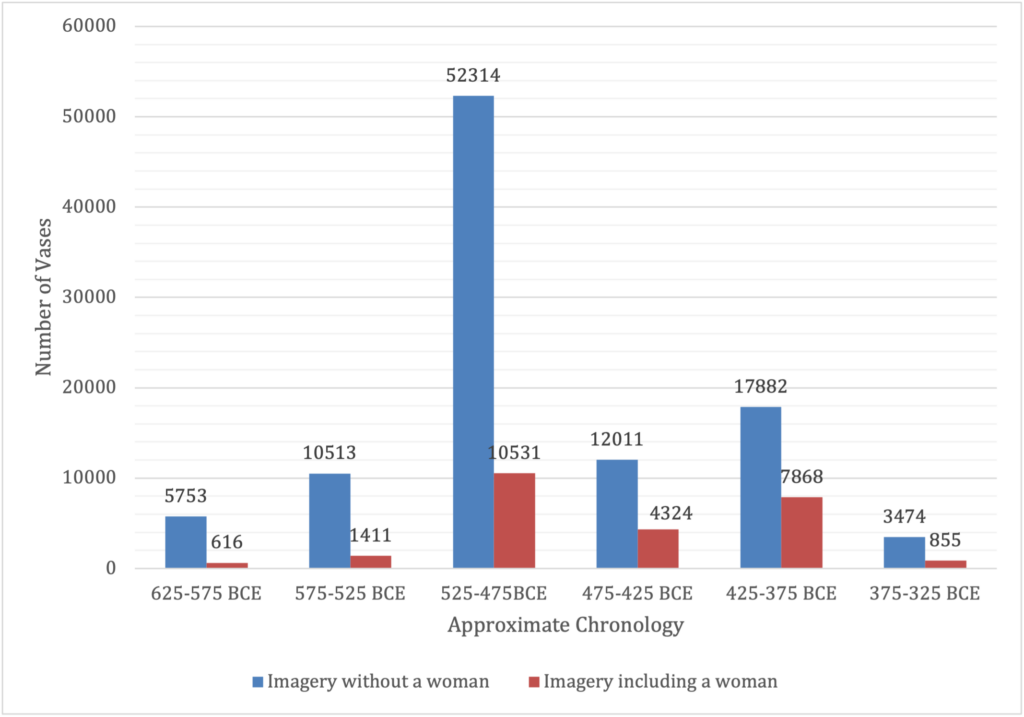
In the fifth century, there seem to be images crafted for women, like targeted advertisements on shapes intended to be used by women. [15] While targeted imagery is not new to Athenian figural pottery, during the fifth century BCE we see a rise in vase shapes intended for female usage, including those related to weddings, those for use within a domestic setting, and those used for funerary assemblages. [16] In particular, there are relatively dramatic shifts in the production of loutrophoroi, lebetes gamikoi, and pyxides, which are all shapes more strongly associated with women, from the sixth to fourth centuries (Figure 2). Weddings, domestic work, and funerals are occasions when women would have engaged with these objects directly.
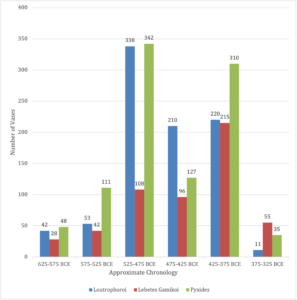
2. Images of Women
Images of women, mortal and immortal, performing similar tasks often appear on these shapes. The pairing of the imagery and vase shapes suggests that women are now the intended customers for some vases, such as on the occasions when images depicting wedding activities occur on shapes that would be used in the wedding by women. For instance, one lebes gamikos features a domestic scene with a loutrophoros carried by one woman towards a seated female musician, which has been identified as a depiction of a bride with attendants (Figure 3). [17] Such reflexive images encourage the female viewer to self-identify with depicted figures, while also reinforcing the visibility of ordinary, non-mythical female figures. This identification creates a more direct connection between object and viewer. The ancient viewer could draw on his, or now her, own life experiences in order to contextualize the details of the image as well as to bolster the cultural visibility of marriage in Athens during this period.
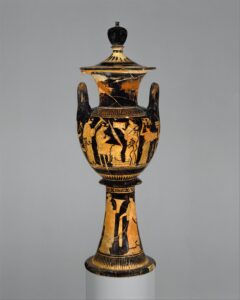
Now, in this study we are considering how ordinary, mortal women are portrayed, rather than mythical, legendary, or divine women. Consequently, I will focus in this paper on scene types that feature mortal women: images of working women, domestic scenes, and the wedding. Using the term “working women,” however, can have certain connotations, specifically with regards to prostitution and hetairai. Erotic images of prostitutes are certainly a type of working woman image that appears in Athenian vase-paintings during this time. [18] Nude women may appear in clearly defined erotic scenes of sex acts, or have other iconographic markers indicating a possible status as a prostitute, but there are also scenes when that is not the case. Scholars such as Ulla Kreilinger have argued for considerable reworking of our understanding of female nudity in Athenian vase-painting. [19] I agree with Kreilinger that this rethinking is needed; however, owing to the constraints of the present paper, I shall limit my present discussion of these images to a few general remarks on the appearance of female nudity in vase-painting. [20] Images of nude and partially naked women were relatively rare in the Archaic period (Figure 4). [21] Instead, the majority of these images date to this very period of change in Athenian society occurring between 500 and 450 BCE. Some images of partially or fully naked women depict settings that would be appropriate for citizen women, such as preparations for the wedding that may have had an erotic subtext, while others may have exclusively erotic contexts.
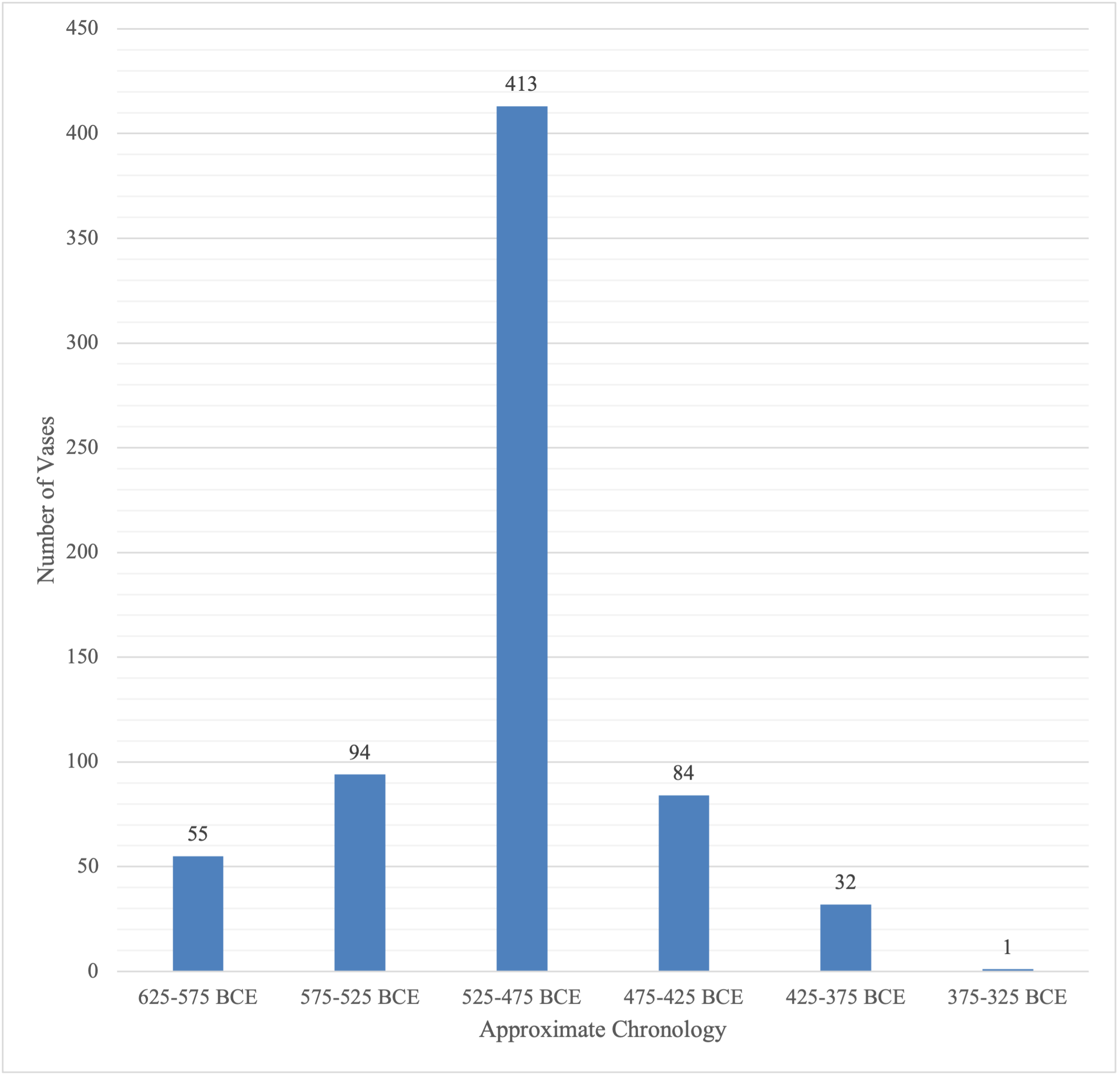
Additionally, not all nude women, or partially nude women, are mortal, ordinary women. For instance, sometimes partially naked women have animal skins tied around their shoulders suggesting that they are Maenads, rather than conventional mortal women. On some occasions, mythological women are shown nude or partially nude, such as the case in representations of the rape of Cassandra. [22] Other images of nude women appear to be ambiguous, potentially showing mortal or immortal women without indicators of status. [23] While female nudity does become more prevalent in the imagery of the early fifth century, [24] there is a sharp decline after that initial burst, the market for these subjects may not be local, [25] and it does not follow the same trends of images women within the home.
2.1 In the home
Xenophon and Plato, among other ancient authors, discuss the importance of wool-working, education, and household tasks for women. [26] At times, male figures are praised for responsibilities on a state level that could be analogous to desirable behaviors of women in the household. One example is the fiscal responsibility and duty of Pericles (Plutarch Pericles 16), which could mirror the duty of women to manage the household, produce textiles, and the praise of female industriousness as a virtue. Other texts suggest that respectable women were educated, including being literate, as well as trained to play musical instruments or to dance. [27] This education, however, is not to the same level of their male counterparts and mainly was organized on a household level. A body of fifth-century red-figure vase-paintings shows such girls and women in scenes of music, such as the lebes discussed earlier, dance, or literary training. [28] The literacy of Athenian women remains a contested topic, but Matthias Steinhart has noted that women with book rolls (scrolls) begin to appear around 460 BCE in vase-paintings and that at least some women could probably read texts. [29] While there is a lack of literary evidence that clearly defines women’s education, texts and images suggest that some women were educated during the time of the arkhē, although this education was primarily related to the running of the oikos.
2.2 General domestic scenes
General domestic scenes, without specific tasks, are more popular during this period (Figure 5). [30] The term “domestic scene” is very broad, encompassing scenes of everyday life, often those that occur within an indoor setting. Indicators of an indoor setting include hanging objects, boxes, baskets, and furniture, but it is important to note that domestic activities could also take place outdoors. Domestic scenes can include a single woman or multiple women, sometimes incorporating music, wool-working, or childcare. These domestic images can give us a better idea of the social expectations for citizen women during the Athenian arkhē based on the types of activities represented. Similarly, there is an increase in the number of images showing specific domestic tasks in the Classical period (Figure 6). [31]
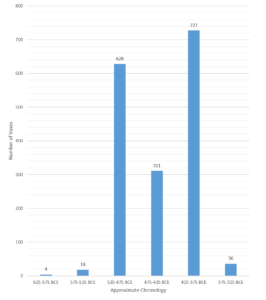
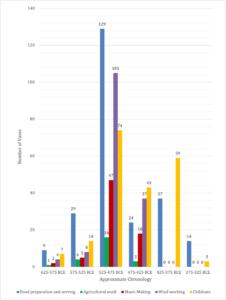
The task-specific subjects are still relatively rare, only representing 1% of subjects in fifth-century vase-painting, but encompass different ways women were educated within and contributed to the success of Athenian households. This could include activities outside the home, such as agricultural images that appear on vases, usually in the form of vineyards or trees and sometimes with depictions of actual fieldwork. [32] Scenes of food preparation do not occur on the shapes actually used for grinding grain or baking. They do sometimes appear on serving vases, just usually not the same shapes for serving the dishes actually prepared in the imagery, such as a lekythos showing two women dishing out soup from a skyphos and a loaf of bread (Figure 7). [33] The appearance of domestic scenes, including those task-specific ones of agricultural work, food preparation, and serving imagery, corresponds to increased interest in showing scenes of everyday tasks, especially by specific painters such as the Pan Painter. Industriousness is an attribute visually emphasized in these images as a desirable virtue for women.
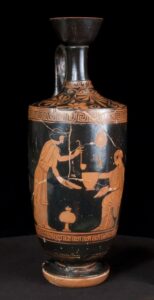
2.3 Musicians
Music also features within the everyday life of ancient Athenian women. Musicians, both male and female, are commonly depicted in Greek vase-painting, including on sympotic pottery directed at male viewers and on vases directed at female viewers. Musicians in vase-painting comprise a large category with expansive variability, which has been explored by scholars such as Sheramy Bundrick. [34] A recently excavated example discussed by John Oakley shows two female musicians playing in a clearly domestic scene in which a child is present. [35] Female musicians appear in distinctive visual contexts relating to cultic activity, domestic settings, and the symposium. Thus, music could be a religious rite, personal entertainment, or even a job, depending on the context and social status of the musician.
2.4 Wool-working
Scenes of wool-working increase in popularity during the first half of the fifth century. [36] Wool-working was a task assigned to the women in the oikos and associated with ideal female behaviors in Classical Greece. [37] It is discussed in a variety of sources, including Xenophon and Plato, [38] unlike other domestic tasks such as cooking, which were rarely discussed in texts. Given the importance of wool-working as portrayed in the literary sources and the prevalence of spindle whorls, distaffs, and loom-weights at excavations, wool-working was an important household industry. The ability to produce textiles was considered a necessary skill for a marriageable woman [39] and the weaving of a peplos for Athena is a well-known component of the Panathenaic festival. [40] The connection between women, wool, and weaving is further emphasized by its inclusion and references in myths, such as Penelope weaving the shroud for her father-in-law in the Odyssey, Ariadne giving thread to Theseus for the Labyrinth, and Philomela weaving a tapestry for her sister. Weaving was likely done on a household level by the same class of women who would have viewed these objects, [41] although it is evident from literary sources that the products of weaving could be sold to support the family. [42]
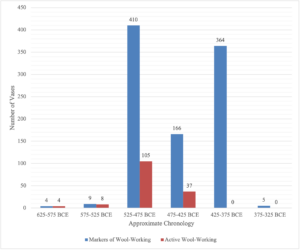
In addition to depictions of active wool-working, many vase-paintings include elements of the process (Figure 8). [43] Domestic scenes with markers of wool-working (i.e. full wool-baskets [ kalathoi ], hanging handlooms, or unused stand looms in the scene) use these elements as ideological markers that remain popular until around 400 BCE, far beyond when active depictions of wool-working appear. [44] Both types of representations related to wool-working are most likely to be directed to female viewers, to have specific messages about cultural expectations, and to have had features with which the women could relate and understand. Scenes of wool-working likely represent a somewhat fanciful understanding of wool-working, but the images emphasize “… the wife’s contributions to the oikos, whether she is doing the weaving herself or supervising someone else’s work.” [45] The visual prominence of wool-working can act as a status marker itself, which is especially true when wool-working images appear on shapes appropriate for wool-working, such as epinetra (Figure 9). [46]
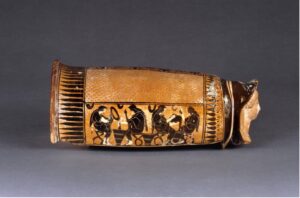
The representations of wool-working show groups of women whose status is not immediately apparent in the depictions, but who are clearly involved in wool-production. They usually wear chitons, sometimes with mantles, and occasionally jewelry. [47] Objects that commonly appear in the scenes with wool-working women include baskets, wool, spindles, chests or boxes, bundles of cloth, and looms, all items related to wool production, as well as sometimes wreaths, flowers and plants, purses, and other vases, such as alabastra. [48] The attention of the viewer shifts from the figures to the industry-related objects through the body positions, gestures, and gazes, each of which serves to emphasize their importance and identify the scene type. Wool-working is an appropriate activity, and representation, for a woman of any status (whether married, widowed, divorced, unmarried, aristocrat, citizen, noncitizen, servant, or slave), as each could be involved in the household industry. [49]
Not only do the vase-paintings contain information about women’s work, they also act as an agent of communication by encouraging the women to relate to the figures within the image. Kelly Wrenhaven indicates that wool-working was associated with women of all social classes. [50] Thus, the question goes beyond just representations of upper-class women and wool-working and into the actual cultural expectations for ancient Athenian women. The activities depicted are familiar to women of different ages and statuses. The increased representations of women and wool-working, and the enlarged group of images containing indicators of wool-working, emphasize the necessary industriousness of women in the household, or at least the desired productivity.
2.5 Childcare
Along with domestic tasks such as textile production, Athenian women were expected to produce citizen children. As such, childcare, especially of young children, had long been associated with the women of the household in Athens and appeared in the imagery (Figure 10). [51] During this period of change in Athens, children increasingly appear in vase-painting beginning around 500 BCE in incremental steps, with their popularity peaking around 400 BCE. Images of a woman with a child, on the other hand, are more common around 500, but consistently appear until around 350 BCE, when only a few vases feature the combination. During the period of the Athenian arkhē, images of small children and women typically include the children playing in the household while observed by female family members, being handed to and/or held by a seated woman who is usually well dressed, or sometimes participating in processions. In these scenes, children are often more in the center of the images, rather than relegated to the sides of images. These types of images visually indicate a shift in the importance of children for the women, placing an emphasis on motherhood, and then overall on children.

2.6 Weddings
The rise in the depictions of children during this period correlates with a rise in depictions of the wedding (Figure 11). [52] It is during the fifth century, during the time of the Athenian arkhē, that the maternal line gains importance for the citizenship of children. In general, we know more about the wedding, documented through songs, religious doctrines, and philosophical texts, than many other occasions and aspects of the lives of ancient Greek women. [53] Xenophon writes about the expectations that the bride has as well as the expectations of the bride in her new household in the Oeconomicus. [54] Wedding images include events that take place both within the oikos as well as outside of it, making these scenes an important bridge between the domestic life of women and their more public role in Athenian society. Weddings included the physical move to a new home for women, as well as indicating a young woman’s transition into adulthood in ancient Athens. [55] A comparison of wedding images produced throughout the fifth century BCE shows a change in how women are portrayed and how they interact with others. Previous work on the Athenian wedding, such as that of John Oakley and Rebecca Sinos, [56] used the textual and visual sources to reconstruct the steps of the wedding. In this study, I consider fifth-century images positively connected with the wedding with a view of elucidating how the images construct a relationship between women as well as between the portrayed groom and his bride.
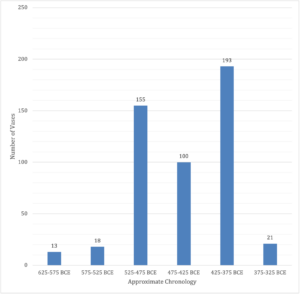
Wedding scenes primarily include representations of the preparations of the bride, the wedding procession, and the ceremony. [57] The bride is typically identified by being the focus of attention of the other figures in the scene, usually the central figure in the composition, who is wreathed or about to be wreathed, and attended by other women. Adornment, especially of the bride, is a significant feature of many of the preparation scenes, possibly relating to its importance in the wedding itself, with the bride going through rites prior to her marriage including dedicating her clothing as a girl, and sometimes hair, at sanctuaries, and a ritual bath. [58] Only in wedding imagery does the lifting of the veil gesture occur, [59] generally associated with feminine aidos, in which one person adjusts the clothing of another figure. While wool-working is a significant component of a wedded woman’s household tasks, the lifting-the-veil gestures associated with marriage are not included in the wool-working images. Only a few images include a female touching her own face, but more images show a woman lifting one hand with the palm upwards. This gesture and differential interactions invite the viewer to see herself within established cultural norms and boundaries, as an honorable and industrious figure involved in specific wedding rites or firmly within the domestic setting.
Generally, only one male figure is included in the wedding scenes, understood to be the groom. The groom interacts with his bride through body language, gesture, and gaze, with all of his attention on her. The wrist-grasp gesture, seen in pursuit scenes and wedding images, visually and physically links the two figures. [60] During the fifth century, this gesture is gradually amended to be a hand-clasping gesture, which is perhaps more romantic, but still showing the connection between the two figures. Women rarely reciprocate the gaze of male figures in working or domestic scenes, but they sometimes do reciprocate the gaze of the groom in these wedding scenes. Now, women do frequently reciprocate the gaze of men in sympotic scenes, but do so while reclining on the same piece of furniture. The reciprocated gaze between men and women may hint a physical relationship between the two figures, although in very different contexts (the symposium and the wedding).
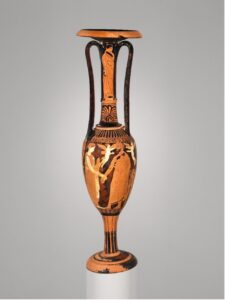
There are also instances when a small flying Eros, or multiple erōtes, appear, such as on a loutrophoros in the Metropolitan Museum of Art (Figure 12). [61] The wedding imagery shows an idealized view of this cultural institution, ideas about love, and divinely endorsed by the erōtes. The wedding scenes include the groom, often as the only male, in procession or ceremony scenes, but he does not appear in the preparation scenes when the bride is surrounded by her female family members. In general, wedding scenes focus on what the wedding is for women: an important transition point in their lives. The individuals portrayed in these fifth-century images encourage the female viewer to self-identify with a figure in the scene through the depictions of recognizable objects, common settings, expected behaviors, communal activities, and shared experiences. These images reveal expectations of how females interact and encourage one another that are different from male-female interactions in both domestic and wedding settings.
3. Men and women
Sympotic imagery, which also increases during the first half of the fifth century, does sometimes include female figures. Women in these images are shown holding their hands towards others, lifting objects, and reciprocating gazes with male figures. Females within the sphere of the symposium are represented as directly interacting with men, sometimes even twisting their bodies towards the male figures sitting or reclining next to them on the same piece of furniture, occasionally drinking, sometimes undressing, or standing in front as an object to be gazed upon while playing an instrument. [62]
In contrast, the vase-paintings of domestic scenes and the wedding contain women who perform veiling gestures, hold objects closer to their bodies, do not sit on the same furniture with men, and for the most part do not reciprocate gazes with the few males depicted. [63] For instance, in this domestic scene with a seated woman, the youth stands on the opposite side of a table (Figure 13). [64] The woman looks downward, not meeting the gaze of the young man. There are far fewer males depicted within the vase-paintings directed at female viewers overall, but those that do appear are often only directly interacting with one woman, usually through a hand-clasp, or wrist-grasp, and direct gaze, even when appearing in a large gathering; otherwise, they interact with other males. The different types of interactions between male and female figures, [65] portrayed in the distinct imagery motifs, most likely relate to the different social status of the female figures depicted as much as reflecting the social situations represented. In general, the visual markers within these images of women are applied differentially for male- and female-targeted audiences in Athenian society in the fifth century BCE.
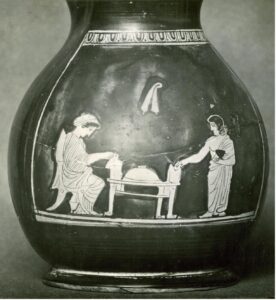
4. Conclusions
After the Persian Wars, Athens takes hegemonic control over the Delian League and, by doing so, places itself at the head of an empire stretching far beyond the borders of Attica. The fifth century BCE marks a period of wars and change in Athens. Between fighting the Persians and then the Peloponnesian League, Athenian male citizens spend much of the fifth century away from Attica, at least seasonally. [66] The mid-fifth century in particular is a high point in Athens itself, a Golden Age, with moving the treasury to the city from Delos, massive construction projects such as the Parthenon, major fluctuations in the population, and changes in the citizenship laws. The literary sources emphasize these changes, but do not focus on how these changes directly affect women. Historical information from Athens at this time (such as is discussed in the contributions of Figueira, Hershkowitz, and McGlin to this volume), decrees, and Greek drama, as well as the texts of authors such as Thucydides, reveal specific information about Athens and its role during this period. [67] In general, these sources are male-dominated in both their origins and perspectives.
The figural imagery of Attic pottery undergoes many changes during the fifth century BCE relating to the increased wealth in Athens. The possibility of upward social mobility for individuals in the thetic class to become hoplites [68] and the increasing wealth of the zeugitai (the class of heavy infantrymen) during the time of Athenian hegemony most likely led to increased preferences for imagery with a broader social appeal. [69] Depictions of virtuous and upper-class women could represent the type of life that women in the lower social classes would hope to attain during this period of growth. [70] Additionally, the Athenian imagery of women during this time illustrates the effects, primarily the increased importance and thereby visibility, of women overall during the Athenian arkhē. While women typically are a silenced class in Athenian public society, the changes in vase-painting during this time reflect the transformation of women’s roles. Not only are there simply more images of women in Athenian vase-painting, but it now seems that, at least some, of these images are targeted towards female viewers and emphasize specific social ideals. Concerning the status of women during the fifth century in Athens, the most important and clear political change was Pericles’ Citizenship Law, which may reflect more gradual social developments. The law emphasizes the status of women, marriages within Athenian citizenry, and the production of Athenian-born heirs during the time of the Athenian arkhē and at the height of its prosperity, which corresponds with the rise in popularity of general domestic images.
It is also during this period when a number of medical texts concerning the health of women appear, although these texts are not specifically from Athens, but do derive from the Athenian arkhē. Many of the texts in the Hippocratic Corpus focus on puberty, conception, pregnancy, and childbirth, emphasizing a particular role of women: motherhood. The increased representations of women with children and children on vase-paintings similarly emphasize motherhood as an important social expectation in Athens during this time. Fifth-century plays, such as Aristophanes’ Lysistrata, reveal the anxiety about women being alone while their husbands are at war, the dangers of losing their sons and husbands, or the difficulties of having to raise children as widows. [71] After the Athenian oligarchic coup of 411 BCE, the state decided in 410 to reaffirm and extend its support for war orphans financially, which is preserved in a decree. [72] Along with the problems of supporting children without fathers, fathers without legal heirs faced difficulties in determining the future of their estate. For instance, Pericles later in his life sought to have the Citizenship Law amended regarding sons born outside wedlock after his legal heirs had died. [73] When considering these lines of evidence together, it is possible that the proliferation of images of children represents an anxiety about Athenian identity, the preservation of the oikos, and the continuation of the polis along with an increased significance of women during this time. The trends in vase-paintings during this period appear to correlate with these political changes. In particular, we can draw attention to the increased production of vase shapes for female usage as well as the surge in the depictions of domestic tasks, including childcare.
While the social institutions in which the vase-paintings intended for male and female viewers were used vary, they have a similar purpose: to conform to and to reinforce the cultural and social institutions themselves, as well as to confirm the status of an individual or even individuals. Some of these images of women reinforce idealized feminine behaviors, while others highlight the complete opposite through specific examples, sometimes on the very same object. One strong example of such a pairing is an epinetron that shows weaving women on the user’s right side (Figure 14) and representations of Amazons on the user’s left side (Figure 15). [74] Amazons are women who behave outside of social norms and violate the traditional social order. This imagery both construes and visually reinforces particular social expectations during the Athenian arkhē: how women should behave and how they should not.
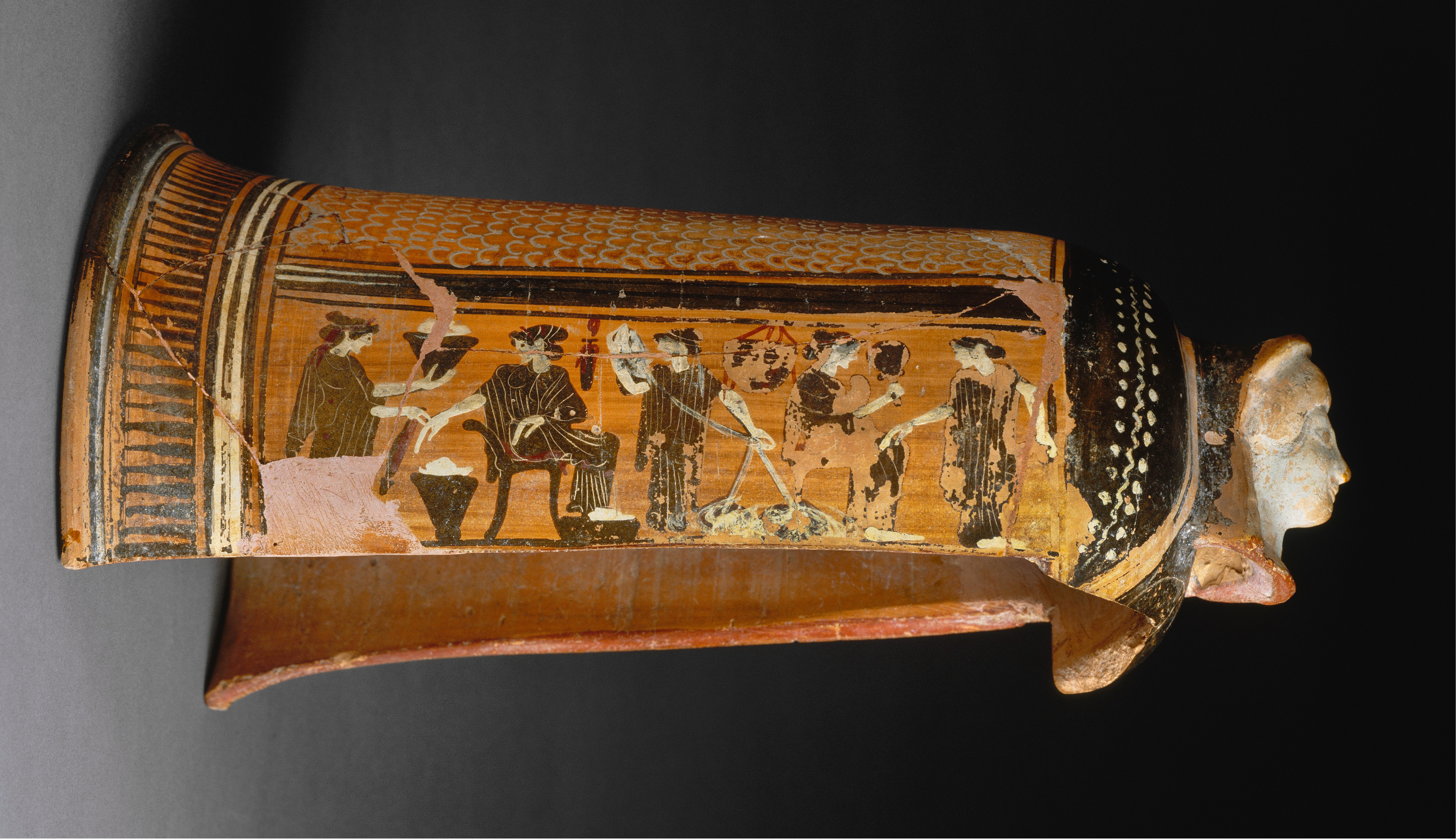
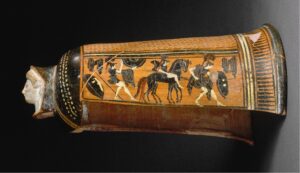
The depictions of women in domestic, working scenes, and wedding images are of what we may call “anonymous” or “conventional” women. They are female figures with whom a female viewer could identify, regardless of station. The imagery includes a variety of women with whom a female viewer could self-identify, differentiated by attire, hairstyles, and adornment: a bride can see herself as the woman at the center of activity in the wedding scenes, or in a scene about the domestic activity she will now be directing, including caring for a future child. Other female viewers could place themselves in the scenes as well through the appearance of specific activities. The shapes on which the depictions occur emphasize the relatability of these images to a female audience. The anonymous portrayals of women would be suitable for both male purchasers and female viewers, who could relate the images to those they know and to themselves, respectively, especially concerning favorable attributes of industry, virtue, and modesty. The inclusion of possible deities, Eros, and personifications such as Aretē (Virtue), Eirēnē (Peace), Harmonia (Harmony), Hygieia (Health), and Peithō (Persuasion), among others, in vase-paintings underscore the general idealizing portrayal of the world of women. [75] The reiteration of these themes of women at work, in the home, and at the wedding, sometimes with added elements, convey the societal expectations, but also fortifies the importance of women by visually reinforcing and even creating perspectives of the cultural events themselves. The images accentuate the cultural expectations for a woman in Athenian society during this time of political and social changes.
The textual sources and the visual representations reinforce the fact that Athenian women were expected to marry an Athenian man, to run their household, and to bear children. These activities are vital for the continued success of the Athenian polis and arkhē. The images encourage the viewer to be self-reflective: to think about the activity he or she is doing while viewing an object meant to be used in that activity, to place himself or herself into the activity depicted in the image, to consider the importance of these tasks both for the household and for society at large, or to contemplate the results when the social norms are violated. While the images would speak to a broad audience, they would especially appeal to women finding themselves now established in a higher status. In conclusion, during the Athenian arkhē, there is a shift in the imagery of vase-painting to emphasize the fair ladies of Athenian society, echoing their rise in importance and their contributions to society for the future citizens of Athens.
Bibliography
Arrington, N. T. 2014. Sacred Space and the Fallen Warrior. New York.
Avramidou, A. 2011. The Codrus Painter. Madison.
Barzetti, A. 2012. The Weaving Women of Athens: Attic Vase Paintings of Women Working with Wool. MA thesis, State University of New York at Buffalo.
Beaumont, L. A. 2003. “The Changing Face of Childhood.” In Coming of Age in Ancient Greece: Images of Childhood from the Classical Past, ed. J. Neils, J. Oakley, K. Hart, and L. Beaumont, 59–84. New Haven.
Bennett, D. S. 2017. Decoding Meaning in Athenian Vase-Painting of the Archaic and Classical Periods: A Study of Expressions of Communication and Targeted Audiences. PhD diss., Bryn Mawr College.
———. 2019. “Targeted Advertising for Women in Athenian Vase-Painting of the Fifth Century BCE.” In “Ancient Mediterranean Painting (vol. 1),” ed. A. Giesecke and M. Stansbury-O’Donnell, special issue, Arts 8, 52. https://doi.org/10.3390/arts8020052.
Blundell, S. 2002. “Clutching at Clothes.” In Llewellyn-Jones 2002:143–170.
Bonfante, L. 1989. “Nudity as a Costume in Classical Art.” American Journal of Archaeology 93:543–570.
Bundrick, S. D. 2005. Music and Image in Classical Athens. New York.
———. 2008. “The Fabric of the City: Imaging Textile Production in Classical Athens.” Hesperia: The Journal of the American School of Classical Studies at Athens 77:283–334.
———. 2019. Athens, Etruria, and the Many Lives of Greek Figured Pottery. Madison.
Cairns, D. L. 2002. “The Meaning of the Veil in Ancient Greek Culture.” In Llewellyn-Jones 2002:73–94.
Cohen, B. 1993. “The Anatomy of Kassandra’s Rape: Female Nudity Comes of Age in Greek Art.” Source: Notes in the History of Art 12:37–46.
Ferrari, G. 2003. “What Kind of Rite of Passage Was the Ancient Greek Wedding?” In Initiation in Ancient Greek Rituals and Narratives: New Critical Perspectives, ed. D. B. Dodd and C. A. Faraone, 27–42. New York.
Figueira, T. J. 1991. Athens and Aigina in the Age of Imperial Colonization. Baltimore.
———. 1998. The Power of Money: Coinage and Politics in the Athenian Empire. Philadelphia.
Filser, W. 2017. Die Elite Athens auf der attischen Luxuskeramik. Image & Context 16. Boston.
Frontis-Ducroux, F., and F. Lissarrague. 2009. “Char, Marriage et Mixite: Une Metaphore Visuelle.” In An Archaeology of Representations: Ancient Greek Vase-Painting and Contemporary Methodologies, ed. D. Yatromanolakis, 87–97. Athens.
Giudice, F., and I. Giudice. 2009. “Seeing the Image: Constructing a Data-Base of the Imagery on Attic Pottery from 635 to 300 BC.” In Oakley and Palagia 2009:48–62.
Goldman, M. L. 2015. “Associating the Aulêtris: Flute Girls and Prostitutes in the Classical Greek Symposium.” Helios 42:29-60.
Gondek, R. 2013. Dress and Nuptial Imagery in Athenian Vase-Painting. PhD diss., University of Virginia.
Hague, R. H. 1983. “Ancient Greek Wedding Songs: The Tradition of Praise.” Journal of Folklore Research 20:131–143.
Hurwit, J. M. 2004. The Acropolis in the Age of Pericles. Cambridge.
Huysecom-Haxhi, S. 2019. “Aphrodite, Coming of Age and Marriage: Contextualisation and Reconsideration of the Nude Young Women Kneeling in a Shell.” In Hellenistic and Roman Terracottas, ed. G Papantoniou, D. Michaelides, and M. Dikomitou-Eliadou, 259-271. Leiden.
Keuls, E. C. 1985. The Reign of the Phallus: Sexual Politics in Ancient Athens. New York.
Kilmer, M. F. 1993. Greek Erotica on Attic Red-Figure Vases. London.
Kreilinger, U. 2006. “To Be or Not to Be a Hetaira: Female Nudity in Classical Athens.” In Images and Gender: Contributions to the Hermeneutics of Reading Ancient Art, ed. S. Schroer, 229–238. Göttingen.
Kurtz, D. C. 1975. Athenian White Lekythoi: Patterns and Painters. Oxford.
Lanni, A. 2008. “The Laws of War in Ancient Greece.” Law and History Review 26:469–489.
Lee, M. M. 1999. The Myth of the Classical Peplos. PhD diss., Bryn Mawr College.
———. 2015. Body, Dress, and Identity in Ancient Greece. New York.
Lefkowitz, M. R., and M. B. Fant, eds. 2005. Women’s Life in Greece and Rome: A Source Book in Translation. 3rd ed. Baltimore.
Lewis, S. 2002. The Athenian Woman: An Iconographic Handbook. London.
Llewellyn-Jones, L., ed. 2002. Women’s Dress in the Ancient Greek World. London.
———. 2003. Aphrodite’s Tortoise: The Veiled Woman of Ancient Greece. Oakville.
Lovén, L. L. 2013. “Textile Production, Female Work and Social Values in Athenian Vase Painting.” In Perspectives on Ancient Greece: Papers in Celebration of the 60th Anniversary of the Swedish Institute at Athens, ed. A.-L. Schallin, 135–151. Stockholm.
Low, P., ed. 2008. The Athenian Empire. Edinburgh.
Lynch, K. 2009. “Erotic Images on Attic Pottery: Markets and Meanings.” In Oakley and Palagia 2009:159–165.
MacDonald, B. 1981. “The Emigration of Potters from Athens in the Late Fifth Century B.C. and Its Effect on the Attic Pottery Industry.” American Journal of Archaeology 85:159–68.
MacLachlan, B. 2012. Women in Ancient Greece: A Sourcebook. New York.
Mansfield, J. 1985. The Robe of Athena and the Panathenaic Peplos. PhD diss., University of California, Berkeley.
McNiven, T. J. 2007. “Behaving Like a Child: Immature Gestures in Athenian Vase-Painting.” In Constructions of Childhood in Ancient Greece and Italy, ed. A. Cohen and J. Rutter, 85–99. Princeton.
Morgan, J. 2010. The Classical Greek House. Exeter.
Neer, R. T. 2002. Style and Politics in Athenian Vase-Painting: The Craft of Democracy, ca. 530–460 B.C.E. New York.
Neils, J. 1992. Goddess and Polis. Princeton.
———. 2000. “Others within the Other: An Intimate Look at the Hetairai and Maenads.” In Not the Classical Ideal: Athens and the Construction of the Other in Greek Art, ed. B. Cohen, 203–226. Boston.
Neils, J., J. H. Oakley, K. Hart, and L. A. Beaumont. 2003. Coming of Age in Ancient Greece: Images of Childhood from the Classical Past. New Haven.
Oakley, J. H. 2004. Picturing Death in Classical Athens: The Evidence of the White Ground Lekythoi. Cambridge.
———. 2014. “Classical Athenian Female Musicians at Home.” In ΕΓΡΑΦΣΕΝ ΚΑΙ ΕΠΟΙΕΣΕΝ: ΜΕΛΕΤΕΣ ΚΕΡΑΜΙΚΗΣ ΚΑΙ ΕΙΚΟΝΟΓΡΑΦΙΑΣ ΠΡΟΣ ΤΙΜΗΝ ΤΟΥ ΚΑΘΗΓΗΤΗ ΜΙΧΑΛΗ ΤΙΒΕΡΙΟΥ, ed. P. Valavanis and E. Manakidou, 271–278. Thessaloniki.
———. 2020. A Guide to Scenes of Daily Life on Athenian Vases. Madison.
Oakley, J. H., and O. Palagia, eds. 2009. Athenian Painters and Potters II. Oxford.
Oakley, J. H., and R. H. Sinos. 1993. The Wedding in Ancient Athens. London.
Paléothodoros, D. 2012. “Sex and the Athenian Woman: A Contextual Analysis of Erotic Vase-Paintings from Attic Graves of the 5th Century BC.” In The Contexts of Painted Pottery in the Ancient Mediterranean World (Seventh-Fourth Centuries BCE), 21–39. Oxford.
Pomeroy, S. B., S. M. Burstein, W. Donlan, and J. T. Roberts. 2004. A Brief History of Ancient Greece: Politics, Society, and Culture. Oxford.
Pritchett, H. 2017. Representations of Human and Satyr Children through Stages of Childhood Development on Athenian Art of the Late Sixth to the Early Fourth Century B.C.E. An Art Historical and Contextual Approach. PhD diss., Bryn Mawr College.
Reinhardt, C. 2019. “Schaleninnenbild und Betrachter–Präsentation weiblicher Nacktheit am Ende der Archaik und Beginn der Klassik in Athen (ca. 520–460 v. Chr.).” In Nacktheit-transdisziplinäre anthropologische Perspektiven. Erträge der 7. Tagung des Zentralinstituts “Anthropologie der Religion(en)”, Erlangen 11.–13. Oktober 2017, ed. L. Allolio-Näcke, J. van Oorschot, and U. Verstegen, 77–104.
Reitzammer, L. 2016. The Athenian Adonia in Context: The Adonis Festival as Cultural Practice. Madison.
Sabetai, V. 1993. The Washing Painter: A Contribution to the Wedding and Genre Iconography in the Second Half of the Fifth Century BC. PhD diss., University of Cincinnati.
Schmidt, S. 2005. Rhetorische Bilder auf attischen Vasen: visuelle Kommunikation im 5. Jahrhundert v. Chr. Berlin.
Shapiro, A. H. 1993. Personifications in Greek Art: The Representation of Abstract Concepts, 600 – 400 B.C. Zurich.
Smith, A. C. 2011. Polis and Personification in Classical Athenian Art. Boston.
Stamatopoulou, Z. 2012. “Weaving Titans for Athena: Euripides and the Panathenaic Peplos (HEC. 466–74 and IT 218–24).” The Classical Quarterly, n.s., 62:72–80.
Stansbury-O’Donnell, M. 2006. Vase Painting, Gender, and Social Identity in Archaic Athens. New York.
Stewart, A. F. 1997. Art, Desire, and the Body in Ancient Greece. Cambridge.
Steinhart, M. 2003. “Literate and Wealthy Women in Ancient Greece: The Case of the ‘Telesstas Hydria.’” In Poetry, Theory, Praxis: the Social Life of Myth, Word and Image in Ancient Greece: Essays in Honour of William J. Slater, ed. E. Csapo and M. C. Miller, 204–231. Oxford.
Sutton, R. F. 1981. The Interaction between Men and Women Portrayed on Attic Red-Figure Pottery. PhD diss., University of North Carolina at Chapel Hill.
———. 1997/1998. “Nuptial Eros: The Visual Discourse of Marriage in Classical Athens.” Journal of the Walters Art Gallery 55/56:27–48.
Topper, K. 2012. The Imagery of the Athenian Symposium. New York.
Volioti, K. 2017. “On show and on the go: The Advertising language of Athenian pottery.” In “Advertising Antiquity,” ed. F. Carlà-Uhink, M. G. Morcillo, and C. Walde, special issue, thersites: Journal for Transcultural Presences & Diachronic Identities from Antiquity to Date 6, 3–42. https://doi.org/10.34679/thersites.vol6.69.
Wolicki, A. 2015. “The Education of Women in Ancient Greece.” In A Companion to Ancient Education, ed. W. M. Bloomer, 305–320. Chichester.
Wrenhaven, K. L. 2009. “The Identity of the ‘Wool-Workers’ in the Attic Manumissions.” Hesperia: The Journal of the American School of Classical Studies at Athens 78:367–386.
Footnotes
[ back ] 1. This paper was originally presented at the Celtic Conference in Classics in Montreal in 2017. Between that presentation and this publication, I published a contribution going into more depth on trends in the depictions of women in fifth century BCE Athenian vase-painting (Bennett 2019) that incorporated ideas from this paper as well as developed them further. As such, this paper has been modified to reflect that material, but aligns with the original spirit and scope of the paper with a few subsequent additions to the bibliography since then. I would like to thank Michael McGlin and Aaron Hershkowitz for inviting me to be a part of the conference, to contribute to the conference proceedings, and for their comments on my text. I am also grateful to Thomas Figueira for his feedback.
[ back ] 2. Bennett 2019:12.
[ back ] 3. While women could have some public cultic roles, in general the discussions of women’s roles in society during this time are focused on their responsibilities within the household.
[ back ] 4. Pericles’ Citizenship Law of 451/450 BCE (Aristotle, Athenian Constitution, 26.3-4).
[ back ] 5. Avramidou 2011; Hurwit 2004. Other studies, such as Neer 2002, have focused on changes in imagery prior to the Peloponnesian War.
[ back ] 6. Stansbury-O’Donnell 2006:187–229.
[ back ] 7. Giudice and Giudice 2009.
[ back ] 8. Giudice and Giudice 2009:48. At the time of their publication, Guidice and Guidice note that their database has room for future additions.
[ back ] 10. Giudice and Giudice 2009:58.
[ back ] 11. It is important to note that the nearly 124,000 (123,113) entries in the BAPD include pieces ranging from small fragments to complete vessels in black-figure, red-figure, white-ground, and special techniques, sometimes without any figures preserved at all, as well as vases with non-Athenian fabric. The present study focuses only on those entries with Athenian fabric. For a more detailed discussion of the dataset and its limitations, see Bennett 2019:6–7.
[ back ] 12. Pomeroy et al. 2004:143–144. This period of fighting dates between 460 and 445 BCE.
[ back ] 13. The data in this chart and all subsequent charts represents generalized trends for a fifty-year range, but does not reflect exact dates. This is because dates in the BAPD are given in fifty-year ranges that overlap (e.g. 600–550, 575–525 BCE, etc.). The “number of vases” is determined by the number of entries in each category in the BAPD.
[ back ] 14. See Bennett 2019, Figure 3 for the general distribution of Athenian vases with known provenience, but without chronological considerations represented. See Bundrick 2019 for a discussion of Athenian vases in Etruria.
[ back ] 15. Volioti 2017 considers advertising through imagery within the scope of a single workshop, the Leafless Group. See Bennett 2019:2–4 for a more detailed discussion of targeted advertising.
[ back ] 16. For studies on some of these shapes, see: Kurtz 1975; Oakley 2004; Schmidt 2005; Arrington 2014. As an example of targeted advertising prior to this period, but primarily directed at male viewers, consider the imagery on sympotic vases as discussed by Topper 2012 (although Topper does not use the same terminology I do), and the themes discussed by Filser 2017 that are aimed at Athenian men.
[ back ] 17. Attic red-figure lebes gamikos attributed to the Washing Painter, ca. 430 BCE, New York, Metropolitan Museum of Art 07.286.35, BAPD 214881. The Metropolitan Museum of Art identifies it as a bridal scene because of the presence of the loutrophoros: https://www.metmuseum.org/art/collection/search/247915.
[ back ] 18. Erotic scenes are common on sympotic shapes, but are also seen on other shapes. Briefly, see the following and their respective bibliographies for more discussion on that topic: Keuls 1985; Bonfante 1989; Kilmer 1993; Stewart 1997; Neils 2000; Lynch 2009; Paléothodoros 2012.
[ back ] 19. See Kreilinger 2006 for a convincing problematization of the treatment of female nudity in scholarship.
[ back ] 20. This subject provides grounds for future research, constrained at present by the scope of the original paper. The present paper is focused on the broad trends in the depictions of female figures in Athenian vase-painting in the fifth century to create the foundation for this future work. An in-depth study of female nudity in vase-painting which considers the subject matter of the scenes and the contested status of depicted figures will contextualize these representations in terms of the function and find spots of the vases, consider contemporary trends in other media, and locate these changes within a wider sociopolitical context. At present, the author would like to direct readers to Reinhardt 2019, for discussions of nudity within vase-painting, and Huysecom-Haxhi 2019 with regards to terracotta figures.
[ back ] 21. The data in this chart also is presented in Bennett 2019, Figure 16.
[ back ] 22. The rape of Cassandra appears in nearly fifty depictions on Athenian vases during the Archaic and Classical periods, many of which include nudity. See Cohen 1993 for a discussion of female nudity in the context of the rape of Cassandra.
[ back ] 23. Neils 2000:208; Barzetti 2012:22–23.
[ back ] 24. Bennett 2019:17. The trend in depictions of erotic scenes, including those without nudity such as courtship scenes, is similar to the trend of imagery including nude women. The majority of erotic vases, however, including those with explicit sex acts, are not found in Athenian archaeological contexts.
[ back ] 25. Lynch 2009.
[ back ] 26. Morgan 2010:97–102 provides the references to textile production within Athens, including: Xenophon Oeconomicus 7.3, 7.35–7.37, 7.40; Plato Laws 805E and Republic 5.451D–453E; Menander Samia 233; Aristophanes Lysistrata 574–86, fr. 581 KA; Xenophon Memorabilia 2.7–12; Demosthenes Against Eubulides 30–31; Theophrastus Characters 10.14.
[ back ] 27. For education of women in ancient Greece, including sources and problems, see the overview in Wolicki 2015. Specifically concerning the status of women playing the aulos, see Goldman 2015.
[ back ] 28. Oakley 2020:105–109. Oakley refers to a body of more than one hundred vases from the Classical period that show some form of female education.
[ back ] 29. Steinhart 2003.
[ back ] 30. Data in this chart is also presented in Bennett 2019, Figure 6.
[ back ] 31. Data can also be seen in Bennett 2019, Figure 12, presented with the addition of ritual activities, which are not considered here.
[ back ] 32. For example, one cup shows women picking fruit, some with baskets. Attic red-figure kylix attributed to the Wedding Painter from Vulci. 475–425 BCE. Compiegne, Musée Vivenel 1090, BAPD 211213.
[ back ] 33. Attic red-figure lekythos attributed to the Pan Painter, 475–425 BCE, Haverford, Haverford College HC10-5199; L.P.8, BAPD 206359.
[ back ] 34. Bundrick 2005.
[ back ] 35. Oakley 2014. The vase in question is an Attic red-figure hydria in the manner of the Niobid Painter, ca. 450 BCE, from Turnaka, Bulgaria; Plovdiv, Regional Museum of Archaeology IV.13, BAPD 9032479.
[ back ] 36. Scenes of wool-working include the manipulation of raw wool, spinning wool into thread, and weaving.
[ back ] 37. Lewis 2002:61–62; Lee 2015:91.
[ back ] 38. See note 23.
[ back ] 39. Lee 2015:91–93; Lovén 2013:136.
[ back ] 40. Mansfield 1985; Neils 1992; Lee 1999; Stamatopoulou 2012.
[ back ] 41. Xenophon Oeconomicus 7.36 includes working wool as one of the important tasks for the wife.
[ back ] 42. Xenophon Memorabilia 2.7.12.
[ back ] 43. Only active wool-working scenes were included on the previous figure as the expanded category obscured the changes in the other subjects.
[ back ] 44. MacDonald 1981 discusses the emigration of Athenian potters from Athens at the end of the fifth century, which is also when the popularity of many image themes dramatically decreases.
[ back ] 45. Bundrick 2008:317.
[ back ] 46. Attic black-figure epinetron attributed to the Golonos Group, 500–480 BCE, London, British Museum 1814,0704.1205, BAPD 303421.
[ back ] 47. Most depictions do not show jewelry, although sometimes the women wear ribbons in their hair.
[ back ] 48. Bennett (2017:217–321) includes a more detailed discussion of the wool-working images on epinetra as well as the types of objects included in such images.
[ back ] 49. Lovén 2013:136.
[ back ] 50. Wrenhaven 2009:371.
[ back ] 51. For some works examining children in ancient Greek art, with a special focus on vase-painting, see: Neils et al. 2003; Beaumont 2003; McNiven 2007; Pritchett 2017.
[ back ] 52. This figure corresponds with Bennett 2019, Figure 9.
[ back ] 53. Hague 1983.
[ back ] 54. For example: Xenophon, Oeconomicus 7.4–38, 7.41–43, 10.2–13; Demosthenes, Against Neaera. Further sources have been compiled: MacLachlan 2012; Lefkowitz and Fant 2005; Oakley and Sinos 1993.
[ back ] 55. For an older woman remarrying, the wedding would not have the same significance as a rite of passage, but would still mark an important transition in her living situation and status. For a discussion whether the wedding is an initiation rite, see Ferrari 2003, with whom I agree that the wedding was not an irreversible initiation.
[ back ] 56. For example, see the following, among others: Oakley and Sinos 1993; Sabetai 1993; Sutton 1997/1998; Ferrari 2003; Frontis-Ducroux and Lissarrague 2009.
[ back ] 57. Oakley and Sinos 1993.
[ back ] 58. Lee 2015:207–211.
[ back ] 59. There are a variety of gestures with veils as well as types of veils. For more information, see Blundell 2002; Cairns 2002; Llewellyn-Jones 2003; Gondek 2013.
[ back ] 60. In wedding scenes, between bride and groom, it acts as a claim of possession.
[ back ] 61. Attic red-figure loutrophoros, ca. 400 BCE. New York, Metropolitan Museum of Art 75.2.15, BAPD 30367.
[ back ] 62. For a visual breakdown on body language, gaze, gestures, and objects appearing in images targeting male viewers and female viewers, respectively, see Bennett 2017, Charts 6.4–6.7.
[ back ] 63. See Bennett 2017:241–252, for a more detailed discussion of these interactions.
[ back ] 64. Attic red-figure chous, unattributed, 430–410 BCE. London, British Museum 1910,0615.3, BAPD 15462.
[ back ] 65. For further discussion on the interactions between male and female figures in vase-painting, see Sutton 1981.
[ back ] 66. Adriaan Lanni (2008:484) points out that “[t]he norms limiting warfare to the summer season made it possible for a non-professional force of farmers to fight and still get home in time to tend their crops.”
[ back ] 67. Low 2008 gives an overview of sources for the Athenian Empire, including both textual and archaeological sources.
[ back ] 68. Antiphon fr. 61 Thalheim.
[ back ] 69. See Figueira 1991 and Figueira 1998 for information with regards to the economic growth of Athens in the fifth century and its social and political affects.
[ back ] 70. I would like to thank Thomas Figueira for pointing out this connection between the changes in economic wealth and demographics with the trends in the vase images during this period.
[ back ] 71. Reitzammer 2016:60–89. Lysistrata directly comments on this in the play (Aristophanes Lysistrata 587–589). Additionally, Reitzammer argues that the movement of the festival of the Adonia, in which women mourn the death of the young fallen hunter, to the spring in the Lysistrata is possibly a form of political protest to the Sicilian Expedition and countering the patriotism of the funerary oration of Pericles (Thucydides 2.35–2.46).
[ back ] 72. Agora XVI 106A= Attic Inscriptions Online (AIO) 1049. https://www.atticinscriptions.com/inscription/AIO/1049.
[ back ] 73. Plutarch Pericles 37.2.
[ back ] 74. Attic black-figure epinetron attributed to the Diosphos Painter, ca. 500 BCE, Paris, Musée du Louvre MNC624, BAPD 303430.
[ back ] 75. Shapiro 1993; Smith 2011.
